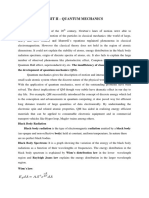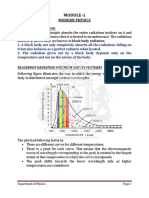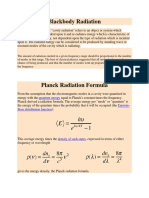Stefan-Boltzmann Law: E S T
Stefan-Boltzmann Law: E S T
Uploaded by
Vijay KumarCopyright:
Available Formats
Stefan-Boltzmann Law: E S T
Stefan-Boltzmann Law: E S T
Uploaded by
Vijay KumarOriginal Description:
Original Title
Copyright
Available Formats
Share this document
Did you find this document useful?
Is this content inappropriate?
Copyright:
Available Formats
Stefan-Boltzmann Law: E S T
Stefan-Boltzmann Law: E S T
Uploaded by
Vijay KumarCopyright:
Available Formats
Planck Radiation Law
The primary law governing blackbody radiation is the Planck Radiation Law,
which governs the intensity of radiation emitted by unit surface area into a fixed
direction from the blackbody as a function of wavelength for a fixed
temperature. The Planck law is represented by the shape of curves in the figure
to the right. The mathematical function describing the shape is called the Planck
function. NOTE THAT BLACKBODY RADIATION HAS EMISSION AT AT
ALL WAVELENGTHS. THIS MEANS THAT IT IS "CONTINUUM
EMISSION."
The Wien and Stefan-Boltzmann Laws
The behavior of blackbody radiation is described by the Planck Law, but we can
derive from the Planck Law two other radiation laws that are very useful. The
Wien Displacement Law, and the Stefan-Boltzmann Law are illustrated in the
following equations.
Stefan-Boltzmann Law:
E= s T4
where s= 5.67 x 10-8 Joule/ (m2sec K4)
Wien Law:
wavelength of peak (in Angstroms)= 3 x 107/T
The Wien Law gives the wavelength of the peak of the radiation distribution,
while the Stefan-Boltzmann Law gives the total energy being emitted at all
wavelengths by the blackbody (which is the area under the Planck Law curve).
Thus, the Wien Law explains the shift of the peak to shorter wavelengths as the
temperature increases, while the Stefan-Boltzmann Law explains the growth in
the height of the curve as the temperature increases. Notice that this growth is
very abrupt, since it varies as the fourth power of the temperature.
You might also like
- Problem 1: A Furnace Cavity, Which Is in The Form of A Cylinder of 75-mm Diameter and 150-mmDocument5 pagesProblem 1: A Furnace Cavity, Which Is in The Form of A Cylinder of 75-mm Diameter and 150-mmMustafa Al KnanyNo ratings yet
- Quantum Physics: Black Body RadiationDocument7 pagesQuantum Physics: Black Body Radiationsmcoolguy68No ratings yet
- Black Body RadiationDocument33 pagesBlack Body RadiationSafnas Kariapper100% (1)
- CHE 301 HW 5 Yousef AlterkaitDocument8 pagesCHE 301 HW 5 Yousef AlterkaitTimelessNo ratings yet
- Quantum Mechanics Assignment (1) - 1Document10 pagesQuantum Mechanics Assignment (1) - 1sobiabilal4242No ratings yet
- Unit-I-Modern Physics & Quantum MechanicsDocument57 pagesUnit-I-Modern Physics & Quantum Mechanicsmwita mwitaNo ratings yet
- Lec 3Document12 pagesLec 3Mahmoud KhalifaNo ratings yet
- CHE 301 HW 5 Abdulaziz AlhoutiDocument7 pagesCHE 301 HW 5 Abdulaziz AlhoutiTimelessNo ratings yet
- Blackbodyradiation 170319074936Document38 pagesBlackbodyradiation 170319074936LokeshNo ratings yet
- Radiation Part IIDocument18 pagesRadiation Part IIcepheus324No ratings yet
- Unit3 PhyDocument66 pagesUnit3 PhyAk JaNo ratings yet
- PHYSICS REPORT Blackbody RadiationDocument10 pagesPHYSICS REPORT Blackbody RadiationScribdTranslationsNo ratings yet
- Unit 1 Quantum Mechanics PDFDocument32 pagesUnit 1 Quantum Mechanics PDFDeveshNo ratings yet
- 1694978371Document30 pages1694978371aksad1991No ratings yet
- Project-Wien's Displacement LawDocument14 pagesProject-Wien's Displacement LawMohammed Nadeemullah NNo ratings yet
- Phy Notes Syl 10Document108 pagesPhy Notes Syl 10vikkumukkaNo ratings yet
- QM - (Phase and Group Velocity)Document17 pagesQM - (Phase and Group Velocity)AdityaNo ratings yet
- UNIT-01: Modern PhysicsDocument28 pagesUNIT-01: Modern PhysicsSree LakshmiNo ratings yet
- Quantum Physics Prasanna BPDocument39 pagesQuantum Physics Prasanna BPMukund KnNo ratings yet
- AbsorptivityDocument4 pagesAbsorptivityAi VInNo ratings yet
- FALLSEM2024-25 BPHY101L TH VL2024250106234 2024-09-03 Reference-Material-IDocument65 pagesFALLSEM2024-25 BPHY101L TH VL2024250106234 2024-09-03 Reference-Material-Idhruvjain632No ratings yet
- Introduction To Quantum PhysicsDocument74 pagesIntroduction To Quantum PhysicsultimuNo ratings yet
- Black Body RadiationDocument12 pagesBlack Body RadiationMahesh Lohith K.S100% (4)
- Modern Physics & Electronics Course Code: PHYS2114 Lecture No.1 Black Body RadiationsDocument22 pagesModern Physics & Electronics Course Code: PHYS2114 Lecture No.1 Black Body RadiationsThis Is Me.No ratings yet
- Unit II QuantummechanicsDocument28 pagesUnit II QuantummechanicsKiran ThunuguntlaNo ratings yet
- Introduction To Qauntum Physics Chapter 40Document95 pagesIntroduction To Qauntum Physics Chapter 40Javed Iqbal SagguNo ratings yet
- Module-1_Modern Physics & Quantum Mechanics Notes - Dr.kk_dSCE - CS StreamDocument25 pagesModule-1_Modern Physics & Quantum Mechanics Notes - Dr.kk_dSCE - CS Streamsharanubm18No ratings yet
- Quantum Mechanics Notes-Part 1Document15 pagesQuantum Mechanics Notes-Part 1aman bhatiaNo ratings yet
- Introduction To Quantum PhysicsDocument72 pagesIntroduction To Quantum PhysicsarunsumbriaNo ratings yet
- Assgn 1Document4 pagesAssgn 1Spandana PrustyNo ratings yet
- QM BasicsDocument12 pagesQM Basicsh.anurag248No ratings yet
- Structure and BondingDocument18 pagesStructure and BondingManas Ranjan SamantarayNo ratings yet
- Blackbody Radiation and Atomic Emission - Unit - 07Document70 pagesBlackbody Radiation and Atomic Emission - Unit - 07TEBATSONo ratings yet
- Study Material/chap.2 Structure and Bonding: Kiita9Document36 pagesStudy Material/chap.2 Structure and Bonding: Kiita9Saurodeep BiswasNo ratings yet
- Unit Ii - Quantum Mechanics: D e A D EDocument25 pagesUnit Ii - Quantum Mechanics: D e A D EChiraag ChiruNo ratings yet
- Quantum Theory of Radiation NotesDocument8 pagesQuantum Theory of Radiation NotesJagadish BNo ratings yet
- 3.laws of Radiation and Their Relevance in RemoteDocument20 pages3.laws of Radiation and Their Relevance in RemoteSujata SarkarNo ratings yet
- Unit 1 Quantum MechanicsDocument41 pagesUnit 1 Quantum MechanicsVimala H CNo ratings yet
- AP NotesDocument124 pagesAP Notessuzanirfan2004No ratings yet
- Laporan Eksperimen Fisika: Radiasi Benda HitamDocument7 pagesLaporan Eksperimen Fisika: Radiasi Benda HitamidhanurNo ratings yet
- Quantum Mechanics Lecture Notes 1Document6 pagesQuantum Mechanics Lecture Notes 1ngupta.araNo ratings yet
- Quantum Physics - AKTUDocument18 pagesQuantum Physics - AKTUrexstore.inNo ratings yet
- 01 Unit 2Document21 pages01 Unit 2Hardik ChhabraNo ratings yet
- Modern Physics and Quantum Mechanics Mod-2 PDFDocument28 pagesModern Physics and Quantum Mechanics Mod-2 PDFShreyas SeshadriNo ratings yet
- Engineering Physics - : BPHY101LDocument7 pagesEngineering Physics - : BPHY101LVenkat BalajiNo ratings yet
- RadiationDocument19 pagesRadiationNajmul Islam ShawonNo ratings yet
- QM Complete Module AKSrivastavaDocument61 pagesQM Complete Module AKSrivastavathedivanshugroverNo ratings yet
- Module 3 Part1Document11 pagesModule 3 Part1LurkingMangoNo ratings yet
- Quantum Physics Basics FoundationDocument31 pagesQuantum Physics Basics FoundationSebastian mdalahelaNo ratings yet
- 02 IntroQuantumPhysicsDocument8 pages02 IntroQuantumPhysicscychan410No ratings yet
- Fallsem2016-17 7570 RM001 14-Jul-2016 Phy1001 EthDocument12 pagesFallsem2016-17 7570 RM001 14-Jul-2016 Phy1001 EthAnirudhNo ratings yet
- Introduction To Quantum PhysicsDocument69 pagesIntroduction To Quantum PhysicsEr Ishan SharmaNo ratings yet
- Unit-1 Quantum Mechanics NotesDocument13 pagesUnit-1 Quantum Mechanics NotesPhantom's NetworkNo ratings yet
- Thermal Radiation: - Classical Theory - Quantum TheoryDocument9 pagesThermal Radiation: - Classical Theory - Quantum TheoryGanantha MarsyafaNo ratings yet
- Wien's Displacement LawDocument14 pagesWien's Displacement LawMohammed Nadeemullah NNo ratings yet
- Lect RadiationDocument7 pagesLect RadiationroshanpateliaNo ratings yet
- Planks constantDocument51 pagesPlanks constantshinchan6996321No ratings yet
- Black BodyDocument29 pagesBlack BodySukhwinder Singh GillNo ratings yet
- 1.Emergence of quantum physicsDocument23 pages1.Emergence of quantum physicsNafis AfzalNo ratings yet
- Quantum mechanics unit 1Document187 pagesQuantum mechanics unit 1aksad1991No ratings yet
- Unified Field Theory in a Nutshell1: The Quest for the Theory of EverythingFrom EverandUnified Field Theory in a Nutshell1: The Quest for the Theory of EverythingNo ratings yet
- Filtration and TypesDocument2 pagesFiltration and TypesVijay KumarNo ratings yet
- Working Principle & Magnetic SystemDocument1 pageWorking Principle & Magnetic SystemVijay KumarNo ratings yet
- Fluid Bed DryerDocument1 pageFluid Bed DryerVijay Kumar100% (1)
- Blackbody Radiation: Quantum Energy Einstein-Bose Distribution FunctionDocument1 pageBlackbody Radiation: Quantum Energy Einstein-Bose Distribution FunctionVijay KumarNo ratings yet
- Flow Through Packed BedsDocument2 pagesFlow Through Packed BedsVijay KumarNo ratings yet
- Game TheoryDocument1 pageGame TheoryVijay KumarNo ratings yet
- Electromagnetic (EM) Spectrum University of Rochester Microwaves Infrared Ultraviolet X-Rays Gamma-Rays NasaDocument1 pageElectromagnetic (EM) Spectrum University of Rochester Microwaves Infrared Ultraviolet X-Rays Gamma-Rays NasaVijay KumarNo ratings yet
- Operating SystemDocument1 pageOperating SystemVijay KumarNo ratings yet
- Circuit BreakerDocument1 pageCircuit BreakerVijay KumarNo ratings yet
- Dry Cell BatteriesDocument1 pageDry Cell BatteriesVijay KumarNo ratings yet
- Classifications of HygrometerDocument1 pageClassifications of HygrometerVijay KumarNo ratings yet
- How Does Gas Chromatography Work?Document1 pageHow Does Gas Chromatography Work?Vijay KumarNo ratings yet
- Principles of SpectrophotometryDocument2 pagesPrinciples of SpectrophotometryVijay KumarNo ratings yet
- Blackbody Radiation: A e B T TDocument2 pagesBlackbody Radiation: A e B T TVijay KumarNo ratings yet
- Vacuum Distillation DefinitionDocument1 pageVacuum Distillation DefinitionVijay KumarNo ratings yet
- Specific Gravity Liquids: Density Water TemperatureDocument1 pageSpecific Gravity Liquids: Density Water TemperatureVijay KumarNo ratings yet
- Pascal's LawDocument1 pagePascal's LawVijay KumarNo ratings yet
- Chilled Mirror HygrometersDocument1 pageChilled Mirror HygrometersVijay KumarNo ratings yet
- Heating With Bunsen BurnerDocument1 pageHeating With Bunsen BurnerVijay KumarNo ratings yet
- Carnot Cycle: Isothermal Processes Adiabatic Processes Second Law of ThermodynamicsDocument1 pageCarnot Cycle: Isothermal Processes Adiabatic Processes Second Law of ThermodynamicsVijay KumarNo ratings yet
- Anemometers Heat A Wire To A Specified Temperature and Then Measure TheDocument1 pageAnemometers Heat A Wire To A Specified Temperature and Then Measure TheVijay KumarNo ratings yet
- A. Psychrometers: HygrodeikDocument1 pageA. Psychrometers: HygrodeikVijay KumarNo ratings yet
- Rain GaugesDocument1 pageRain GaugesVijay KumarNo ratings yet
- Coke Plant - Process DiagramDocument1 pageCoke Plant - Process DiagramVijay KumarNo ratings yet
- Micrometer Screw GuageDocument2 pagesMicrometer Screw GuageVijay Kumar100% (1)
- Explain Hub and It's Working Principle?: Fig: Hub in A Star TopologyDocument1 pageExplain Hub and It's Working Principle?: Fig: Hub in A Star TopologyVijay KumarNo ratings yet
- Online Heat Transfer by Radiation 2021Document49 pagesOnline Heat Transfer by Radiation 2021Jason Yap Han YuenNo ratings yet
- Conduction, Convection, RadiationDocument64 pagesConduction, Convection, RadiationMAx IMp BayuNo ratings yet
- A2 54 A2 AstrophysicssurveyingthestarsDocument67 pagesA2 54 A2 AstrophysicssurveyingthestarsHany ElGezawyNo ratings yet
- Energy ProductionDocument23 pagesEnergy ProductionSkruzdelyte MielaNo ratings yet
- CH 7Document19 pagesCH 7Iratechaos100% (4)
- Instant Access to Thermal Radiation Heat Transfer, 5th Edition ebook Full ChaptersDocument55 pagesInstant Access to Thermal Radiation Heat Transfer, 5th Edition ebook Full Chapterstrenkchanen100% (1)
- PART IIDocument64 pagesPART IIIvan Hernández0% (1)
- BCHCT-131 em 2023@7736848424Document23 pagesBCHCT-131 em 2023@7736848424Anshit GuptaNo ratings yet
- CBSE Class 11 Chemistry Notes - Atomic StructureDocument20 pagesCBSE Class 11 Chemistry Notes - Atomic StructureSanjay Sharma100% (1)
- Pool Fire Model: Damage PotentialDocument9 pagesPool Fire Model: Damage PotentialChooSweeSoon100% (1)
- Steam Generator DesignDocument147 pagesSteam Generator Designzerocool86100% (1)
- Lecture #6 - RadiationDocument8 pagesLecture #6 - Radiationdlo0106bronNo ratings yet
- Gujarat Technological University Chemical Engineering (05) : Process Heat Transfer B.E. 4 SemesterDocument4 pagesGujarat Technological University Chemical Engineering (05) : Process Heat Transfer B.E. 4 SemesterPar PatelNo ratings yet
- Full Notes For Air Conditioning and Ventilation PDFDocument97 pagesFull Notes For Air Conditioning and Ventilation PDFBLa ProductionNo ratings yet
- Heat TransferDocument32 pagesHeat Transfersatish44825% (4)
- Time Dependent SEDocument14 pagesTime Dependent SEabdullhNo ratings yet
- Engineering PhysicsDocument31 pagesEngineering PhysicsJoan VincentNo ratings yet
- Lecture Notes On Heat Mass TransferDocument504 pagesLecture Notes On Heat Mass TransfervisNo ratings yet
- Physical Science Module Q2Document25 pagesPhysical Science Module Q2GUTIERREZ, ANGELICA, TOLENTINONo ratings yet
- Introduction To NDT by Active Infrared Thermography PDFDocument22 pagesIntroduction To NDT by Active Infrared Thermography PDFJose Alejandro Mansutti GNo ratings yet
- HT MCQDocument8 pagesHT MCQElina TripathyNo ratings yet
- AN2773 8 Bit Thermal Camera 00002773ADocument32 pagesAN2773 8 Bit Thermal Camera 00002773Aomputpu1No ratings yet
- First Year Important Very Short Answers by Mr. Hameed Ali Khan M.SC B.Ed (PH.D)Document4 pagesFirst Year Important Very Short Answers by Mr. Hameed Ali Khan M.SC B.Ed (PH.D)Shoaib Al KaseriNo ratings yet
- PME9 Heat TransferDocument8 pagesPME9 Heat TransferKAL ELNo ratings yet
- Physical Chemistry-I: Quantum Chemistry For Competitive Exams 2020Document5 pagesPhysical Chemistry-I: Quantum Chemistry For Competitive Exams 2020Vamsi KattaNo ratings yet
- Manual Heat Transfer Laboratory: Chemical EngineeringDocument59 pagesManual Heat Transfer Laboratory: Chemical EngineeringNilesh JoshiNo ratings yet
- Heat and Mass Transfer MEE 421Document26 pagesHeat and Mass Transfer MEE 421Promise JuniorNo ratings yet
- High Emissivity CoatingDocument12 pagesHigh Emissivity CoatingĐoàn TrangNo ratings yet
- Modeling and Simulation of Heat Transfer PhenomenoDocument13 pagesModeling and Simulation of Heat Transfer PhenomenoCARLOS DANIEL YI VILLAMIZARNo ratings yet



















































































































